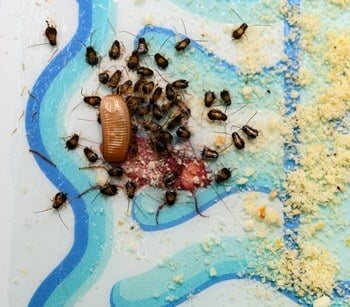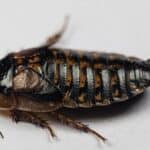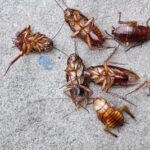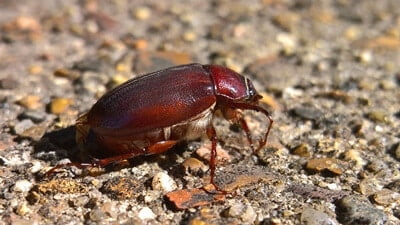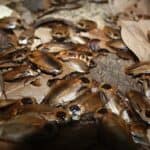Because roaches are insects, you may be surprised to hear that cockroaches produce milk. After all, invertebrates aren’t mammals. Cockroaches are known for laying eggs, not giving birth. It isn’t easy to imagine baby cockroaches lining up to nurse from their mother.
One species of cockroach will nurse, while another will produce milk. The Pacific beetle cockroach produces milk for its young while in utero. These are in the form of nutrient-dense milk crystals. The female wood roach, in contrast, will birth its young and nurse them afterward. She feeds them cellulose while they develop, not milk.
Both species of cockroaches have unique responses to pregnancy. They will usually leave human homes to seek out wood unless bare wood is available indoors. These species need rotting wood to gain the nutrients they need to produce milk. For the Pacific beetle, this milk is so nutrient-dense that humans may even benefit from it.
How Do Cockroaches Feed Their Young?
Some species of cockroaches do nurse their young. However, this trait is only found in special circumstances, among two species of cockroaches. The Pacific beetle roach provides milk but is not technically nursing. In contrast, the wood roach performs an activity more like nursing. However, it’s not technically offering milk.
On the whole, most roach species will feed their young through a different, more complicated process. That’s because cockroaches are terrestrial invertebrates. While mammals have mammary glands that produce milk to nurse their young, cockroaches are insects that lack these organs. As such, they rely on bacteria.
Feeding For Average Cockroaches
Most female cockroaches carry their young in egg sacs. These are located at the end of their abdomen. While the eggs are developing, the mother roach feeds her eggs bacteria. This bacteria comes from a special cell called mycetocytes.
This form of bacteria generation is feeding. However, the process is completely involuntary on the mother’s part. All the eggs do is absorb what the mother’s metabolism already produces. This provides the young with nutrients that help them to develop properly.
Before the eggs hatch, the mother will place the sacs in protected crevices. This could be outdoors, in whatever place it deems best. It could also be in your home. After that, the mother roach does not stay to nurse her young. Instead, she leaves them to fend for themselves.
How Do Cockroaches Nurse?
All cockroach breeds supply the underdeveloped eggs with nutritious bacteria while they develop around the ovaries. To break from the norm, two species of roach do not lay their eggs. Instead, the Pacific beetle cockroach and wood roach birth their young. How each one feeds their young also differs.
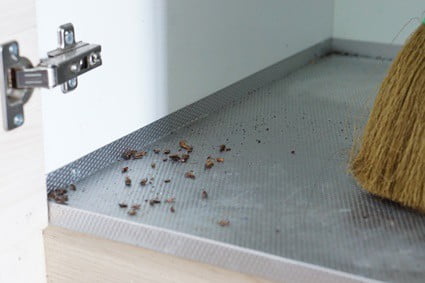
Pacific Beetle Cockroaches
The Pacific beetle cockroach is otherwise known as diploptera punctate, or the cypress cockroach. According to the Institute of Entomology of Southwest University in China, this species closely resembles beetles. They are small, dark brown in color, and have cross-folded wings that reach their abdomens. Pacific beetle cockroaches are viviparous, which means:
- The mother lets her eggs hatch inside of her
- She keeps the young in her uterus until they’ve molted several times.
Because cockroaches are invertebrates, they have a hard exterior that does not expand. To grow, they must shed their skin. The nymphs of this species do this 3 times while in utero.
While the baby cockroaches are still developing in the uterus, the mother will produce milk. Unlike cows or other mammals, this milk is in crystal form, not in free-flowing liquid form. As explained by the Society for Integrative and Comparative Biology, the milk produced by this species of cockroach is:
- Protein-based
- High in calories
The developing young will then store these milk crystals. They will leach off nutrients and use them to grow. The mother’s lactation process only lasts until the nymphs are done molting. Once they are birthed, the mother leaves her young.
Wood Cockroaches
Wood cockroaches are also called cryptocercus punctulatus or brown-hooded cockroaches. All forms are native to North America. They are similar in appearance to the American cockroach but are slightly smaller.
Most species of cockroaches keep their egg sacs on the outside of their body and lay them before they hatch. This type of cockroach is ovoviviparous, which means:
- The mother lets the eggs hatch inside of her
- She births the young shortly after or before they molt
The young are not able to fully develop in utero. The mother wood roach stays with her young to nurse them as they go through their molt stages.
Wood cockroaches nurse their young by feeding them cellulose, which is produced by digesting gut bacteria. Once the nymphs have completed their molt cycle, they are ready to continue growing without the mother.
Why Do Only Some Cockroaches Nurse Their Young?
No one knows for sure why these two cockroaches are the exception to a no-nursing, no-milk rule. However, it’s suspected that they prefer a maternal approach to their young because of their close relationship to other insects. Specifically, these are termites and beetles. Both termites and beetles are eusocial insects. That means they tend to stick together and depend on each other for survival.
The Pacific beetle cockroach is related to beetles (hence the name). Many beetle species care for their young. The wood roach is closely related to termites. According to a study by the Royal Society, because their gut bacteria are genetically similar, termites may have evolved from social cockroaches.
Other cockroach species feed their young involuntarily. It’s a metabolic biological process that exists regardless of whether the roach is pregnant or not. On the other hand, the wood cockroach actively changes her behavior to ensure her offspring survive their first few weeks. Even the Pacific beetle cockroach goes through a biological change. She will actively produce milk until her young finish their molting cycles.
Where Do Nursing Cockroaches Go?
Just before the eggs hatch, most roach species will lay their eggs in warm, damp crevices and leave. You won’t find an egg-carrying roach acting differently from normal roaches. However, nursing cockroaches have a more interesting approach to motherhood.
Wood Roach
These roaches will get pregnant and carry their young just like Pacific beetle roaches. However, their habitat choice differs.
Getting Pregnant
Male wood roaches are attracted to light and are often found near human civilization. As such, young female roaches will stay near light sources to attract males.
Once Pregnant
After properly inseminated, the mother wood roach will migrate to a safe area with an abundant food source. Interestingly, a pregnant roach usually moves outdoors and into wooded areas. That’s different from the typical German and American cockroaches. These species love overstaying their welcome in human environments.
That’s because, much like termites, these cockroaches like to live in wood. The mother wood roach feeds her young by digesting rotting wood and turning it into cellulose. If your home is vulnerable to wood rot, the females may stay. However, nursing wood cockroaches are typically found outdoors under:
- Rotting logs
- Firewood stacks
- Around trees
Humid conditions and high altitudes are ideal for nursing cockroaches. Wood cockroaches nurse their young between summer and spring.
Pacific Beetle Roach
The Pacific beetle cockroach will perform the same routine as the wood roach. However, this species is far pickier about its pregnancy habitat. It’s called the cypress cockroach for a reason. They feast on the bark from:
- Cypress trees
- Juniper trees
The damage Pacific beetle cockroaches do to trees is very noticeable. That’s especially true once the infestation is in an advanced stage. A cockroach-infested tree is surrounded by a moldy-looking brown area at the crown.
Nursing mother roaches live inside and around cypress and juniper trees. This provides them with the food necessary to produce milk. If you have any cypress or juniper trees near you, check them for infestation. The chances are that there are a couple of nursing cockroaches burrowed deep inside a crevice in the bark.
What Is Cockroach Milk Made Of?
Cockroaches nursed by their mother are born in a more developed state. They don’t need to fend for themselves. Likewise, they can molt several times with the protection of their mother, free of outside danger.
In a way, they’re stronger. This is all due to the high levels of protein in the milk they consume. Other cockroach species take months to hatch from their egg. In contrast, the Pacific beetle cockroach is born as a live nymph. It’s strong, and ready to become independent.
The liquid provided by their mother concentrates in their stomachs and crystalizes. As time goes on, the crystals slowly release more and more protein. This further assists the nymphs’ development until they are ready to be born. Cockroach milk is surprisingly nutritious. It contains:
- Protein crystals
- Amino acids
- Carbohydrates
- Omega-3 fatty acids
- Sugar
- Linoleic acid
- Oleic acid
Can Humans Drink Cockroach Milk?
In a technical sense, cockroach milk is good for humans. However, it’s not yet safe to consume.
The Institute for Stem Cell Biology and Regenerative Medicine in Bangalore, India, discovered some interesting facts. Cockroach milk is one of the most nutritious substances ever discovered. It rivals buffalo milk in caloric value and contains more energy than regular cow’s milk.
Scientists are looking into it as the next superfood. It is, however, extremely high in fat and calories. Someone trying to lose weight would not want it in their diet, regardless of whether it comes from cockroaches or not.
Is Cockroach Milk Safe?
Scientists are unsure if cockroach milk is safe for humans to consume in large quantities. Pacific beetle cockroaches are chemically defended. That means they expel a highly toxic poison as a defense mechanism.
This has not stopped some companies in South Africa and Southeast Asia. Here, cockroaches are farmed, milked, and ice cream is made out of roach milk. Scientists already find it difficult, expensive, and tedious to milk cockroaches due to their size. Whatever method these companies are using to extract milk in large quantities from nursing roaches is highly questionable.
This substance contributes to nymphs developing at an accelerated rate. Because of that, researchers are interested in the effects of consuming roach milk long-term. Going theories, as of now, claim it may help people develop faster too. However, until they can mass-produce the milk safely for humans to drink, this is only speculation.
